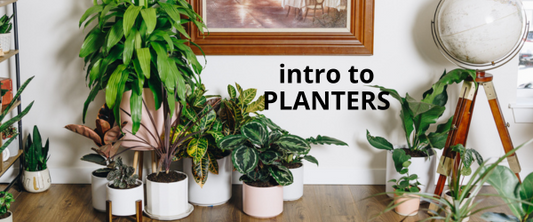Indoor plants make even the boxiest, least inspired studio apartment start to feel like a home. Unlike that rainbow electroplated deer head you picked up from Target, however, plants are living things with needs of their own.
One of the biggest challenges indoor plant caretakers face is ensuring their collection receives appropriate light. Too much and tender leaves end up scorched, but too little results in stunted growth or leggy, unruly stems.
Determine Your Plant's Lighting Needs.
The first step in choosing the right lighting for your indoor plants is to determine their specific lighting needs.
You can usually find this information as part of your plants description online. If you aren’t sure what kind of plant you have or want help understanding it’s lighting needs, a virtual consultation with one of our clinicians can help! Lighting needs are often described in terms of bright direct, bright indirect, medium indirect, and low indirect.
Many plants will tolerate a range of lighting but will thrive if the lighting condition closely matches the environment they are endemic to.
Once you know your plant’s light preferences, it’s time to pull up the compass app on your phone and start taking stock of your windows.
Consider the Placement of Your Plants.

When choosing the right lighting for your indoor plants, it’s important to consider the placement of your plants in your home. Depending on which direction they are facing, some windows will provide higher quality light to your plants than others.
Unobstructed South facing windows provide the most light throughout the day, with West facing windows coming in a close second.
East facing windows can provide bright light in the morning for a few hours, but the light quality will diminish throughout the day.
North facing windows have the least access to natural light and plants near them will likely require some supplemental help from a plant bulb or other grow light.
Now that you know which direction your windows are facing, use your plants unique lighting needs to figure out placement. You may need to move your plants farther from bright windows or use curtains to help filter direct light.
Moving your plants farther from a window can also help decrease the intensity to better meet your plants particular lighting preferences.
Understand the Different Types of Light.
There are two metrics you need to pay attention to when you’re picking out a grow light: Kelvin and Lumens.
Kelvin (K) equals the temperature or color of the light. There is only a limited spectrum of light that plants can use. This spectrum goes from 6500k to 4500k. Blue light, which is 6500k encourages leaf growth. Red light, on the other side of the spectrum at 4500k, encourages root growth and flowering.
As you are shopping for plant bulbs you might also come across some that claim to be full spectrum. Make sure the manufacturer also provides an output value in Lumens to ensure you are getting a bulb powerful enough to actually support your plant’s needs.
Lumens equals light output or intensity of light. The higher the lumens the more light is available for your plants to photosynthesize with. Most grow lights will produce somewhere between 1400 and 5000 lumens.
Most tropical plants want between 300 and 800 lumens per square foot of light coverage, and most succulents want about 10,000 lumens per day.
The lumens determine the intensity of the light produced by the fixture and help determine the quality of the light and how long it will need to be used each day to meet the needs of your plants.
After you have figured out how powerful a light you need, it’s time to figure out which bulb works best for you.
Choose the Right Light Bulbs.
There are a variety of grow lights available depending on what works best with your space and goals.
Plant bulbs are inexpensive options that are compatible with any light fixture that uses a standard bulb like an overhead pendant light or lamps.
There are also high-quality grow lights like Soltech pendant fixtures that provide high enough output to supplement light for a large grouping of plants without sacrificing style or light quality.
Strip lights are another common option. They provide concentrated light and can be discretely integrated into your space to provide light for dense clusters of plants in narrow spaces.
We use strip lights on our shelving inside the shop to ensure plants continue to receive the light they need even when they are quite a ways away from the front windows. Strip lighting also can be used to provide light to plants resting on the top of book shelves or inside of plant cabinets.
Monitor and Adjust Your Lighting Setup.
Once you have chosen the right lighting for your indoor plants, it’s important to monitor their growth and adjust the setup as needed.
Keep an eye on the distance between the plants and the light source, as well as the duration of light exposure each day. If your plants are not growing as expected, you may need to adjust the height or intensity of the lights. Regularly checking and adjusting your lighting setup can help ensure your indoor plants thrive.
Watch your Plants Thrive
There is nothing more exciting than watching a plant flourish and knowing you have provided everything it needs to continue to thrive. By taking the time to understand your plant's ideal lighting conditions and learning about the different methods you can use to meet them you've made an important step towards being a successful plant caretaker.



